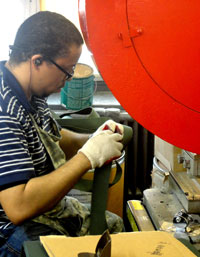National Industries for the Blind Helps Wounded Warriors

Did you know a person is considered legally blind when the best corrected visual acuity is 20/200 or the visual field is 20 degrees or less, meaning he or she can only see the "E" on the eye chart?
Seventy percent of people who are blind lack employment, but NIB has a vision to change that statistic.
Look at the pad of paper you're using to take notes. Look at the pen you're using. Do they say SKILCRAFT? If so, then they were manufactured by the National Industries for the Blind. Employees who are blind have manufactured or assembled those supplies for decades. And that's not all they've manufactured.
NIB and the U.S. Army Medical Materiel Development Activity's Medical Support Systems Project Management Office have worked together for years under the Ability One Program. This Program is a federal purchasing program that implements the Javits-Wagner-O'Day Act, which is a federal law that requires federal agencies to purchase products and services from nonprofit agencies employing people who are blind or have other disabilities. NIB has 90 associated nonprofit agencies all over the country.
"Our partnership with NIB is essential to providing medical support solutions to the Joint Armed Forces," said Steve Hawbecker, project manager of the MSS at USAMMDA.
MSS works with the New York City Industries for the Blind on the patient litter straps that secure the wounded Soldier to the litter, and with Arizona Industries for the Blind on the litter that transports injured Soldiers from the battlefield.
"There is great pride in knowing we are doing our part to support our Servicemen and women while sustaining and creating jobs in one of the country's most densely populated areas for people who are legally blind," said Brenda Mee, Director for NYCIB's Business Development. "This is truly a win-win for all."
New York City Industries for the Blind, Inc. and Litter Straps
NYCIB has not always manufactured the litter straps, but individuals who are blind have. In the early 1990s, Helen Keller Services for the Blind made the straps. When it closed, Lighthouse International of New York City bought the equipment and inventory and hired the HKSB employees to continue manufacturing the litter straps.
When the manufacturing division of Lighthouse International New York City closed, NYCIB was created, hiring all of the displaced blind employees. Successful in securing the Defense Logistics Agency contract for the litter strap, NYCIB has made the litter straps ever since. Every year NYCIB provides 45,000 straps to the military.
Now that the litter straps are changing, MSS began searching for a strap alternative and teamed up with NYCIB to develop strap prototypes with buckle release options that offer greater safety and reliability. Testing showed that the prototype with a strong, load-bearing quick-release buckle with a two-part fastener was more reliable. The new litter strap requires additional stitching, which creates new jobs at NYCIB.
The litter straps are in approximately 75 different medical equipment sets, such as the ground, air, and mine-resistant ambush-protected ambulance sets. The U.S. Army Aeromedical Research Laboratory is finalizing airworthiness certification of the straps, and the new straps will be available in 6 to 12 months.
"This new strap has surpassed our expectations at meeting a capability gap and will greatly improve our ability to evacuate casualties safely," said Jaime Lee, USAMMDA product manager.
Arizona Industries for the Blind and Standardization of Litters
AIB began building litters for the Army in 1982. And they have been improving them ever since. The litters transport wounded Soldiers while helping to prevent further injury. The litter covers are made from a polypropylene mesh material, which is flame retardant and resistant to chemical warfare agents and decontaminating solutions. The litter supports up to 1,600 pounds. For shipping and storage, the litter collapses. Retractable handles allow for easy grip, and aluminum legs provide strong support. All of the components for the litter are machined and assembled by 25 employees at AIB. Each year AIB provides the military with about 20,000 litters.
Now AIB and MSS are working together to modernize the current litter and make a single litter that is compatible with all casualty evacuation platforms (standard ground ambulances, MRAPs, Black Hawk MEDEVAC helicopters, fixed wing aircraft, etc.) while still being a cost-effective solution.
"Standardization of litters in the Department of Army is a big issue, and this is the first step in the right direction to address this," said Lee.
This effort began with a Request for Information from the Field Assistance and Science Technology Team on the many types of litters on the battlefield. With all the different types of casualty evacuation and medical evacuation platforms, litter standardization needs to be addressed. Currently, the standard NATO litter does not fit in the MRAP Ambulances. The new litter will include the strengths of the standard NATO litter, such as decontaminable and folding, and will work in any of our ground and air evacuation assets. In addition, the litter needs to be functional, simple to operate and assemble, compact, and lightweight.
In addition to the reasonable price and employment opportunities, by working with NIB, MSS has a long-term supplier for its products. MSS looks forward to working with NYCIB and AIB and hopefully other NIB agencies in the future.
The views expressed in the Article are that of the authors and do not necessarily represent the views of the U.S. Army.
Litter Straps NSN: 6530-00-784-4205
Standard NATO Litter NSN: 6530-01-380-7309













